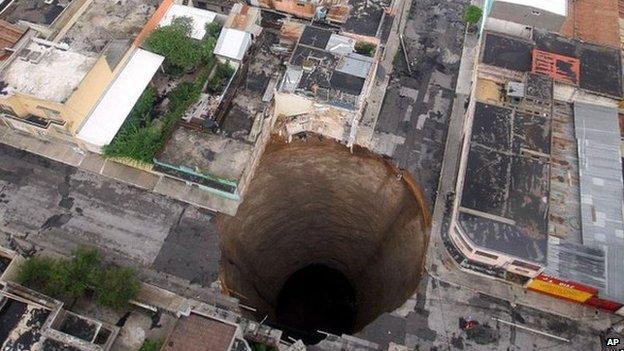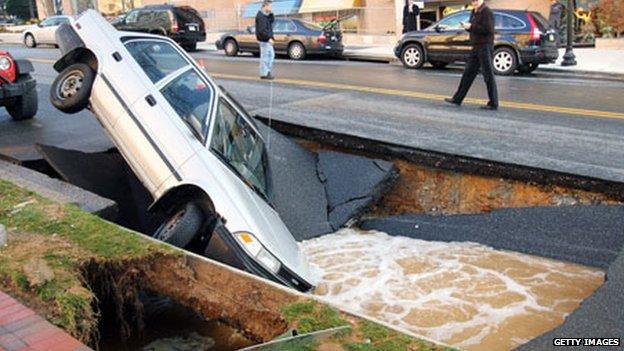Sinkholes: See them, watch them and we explain them
- Published

It's 32ft (10m) wide and 16ft (5m) deep.
This is the hole outside Sarah Jenkins' house in Upper Basildon, near Reading which appeared in 2014.
It's been described as one of the biggest sinkholes in the UK.
But what exactly is a sinkhole and how and why do they open up? Sinkholes can take thousands of years to form and usually happen when rock underneath the ground is dissolved by acid rain.

Like a scene in a disaster movie, this huge sinkhole opened in Guatemala City in 2010
That creates a hole under the surface and then the top level of soil falls through when it can't take the weight above it any more.
The final collapse can take anything from minutes to hours.
In the latest case in Berkshire, the house is sat on top of an old brick factory with underground tunnels.

Watch the video, external of this woman falling into a hole as it opened up in China. She did survive.

Six homes were evacuated after this hole opened in a drive in Florida in November
Rock which dissolves easily, like limestone or chalk, is more likely to be affected. That's why lots of sinkholes appear in Florida, which is built on limestone.
Heavy rain and bad drainage systems can make the holes more likely.
Britain usually has two or three cases a year, but in February 2014 alone, six sinkholes appeared after heavy rain.
Experts also warned more were likely because of the bad weather.


This sinkhole swallowed eight rare cars at a sports car museum in the US state of Kentucky
The world's deepest sinkhole is in China - 2,172ft (662m).
The biggest is 50 miles (80km) by 75 miles (121km) in Egypt.
But many are often just a few metres wide.

A sinkhole caused by a burst water main in Chevy Chase, Washington DC
Are there any warning signs?
There can be some warning signs of sinkholes forming in built-up areas.
You might notice doors and windows aren't closing properly, cracks are appearing in building foundations or you may even feel the ground move.
But it's not easy to predict.
Sinkholes are more common in less built up areas, mainly because developers avoid risky sites.
Follow @BBCNewsbeat, external on Twitter and Radio1Newsbeat, external on YouTube